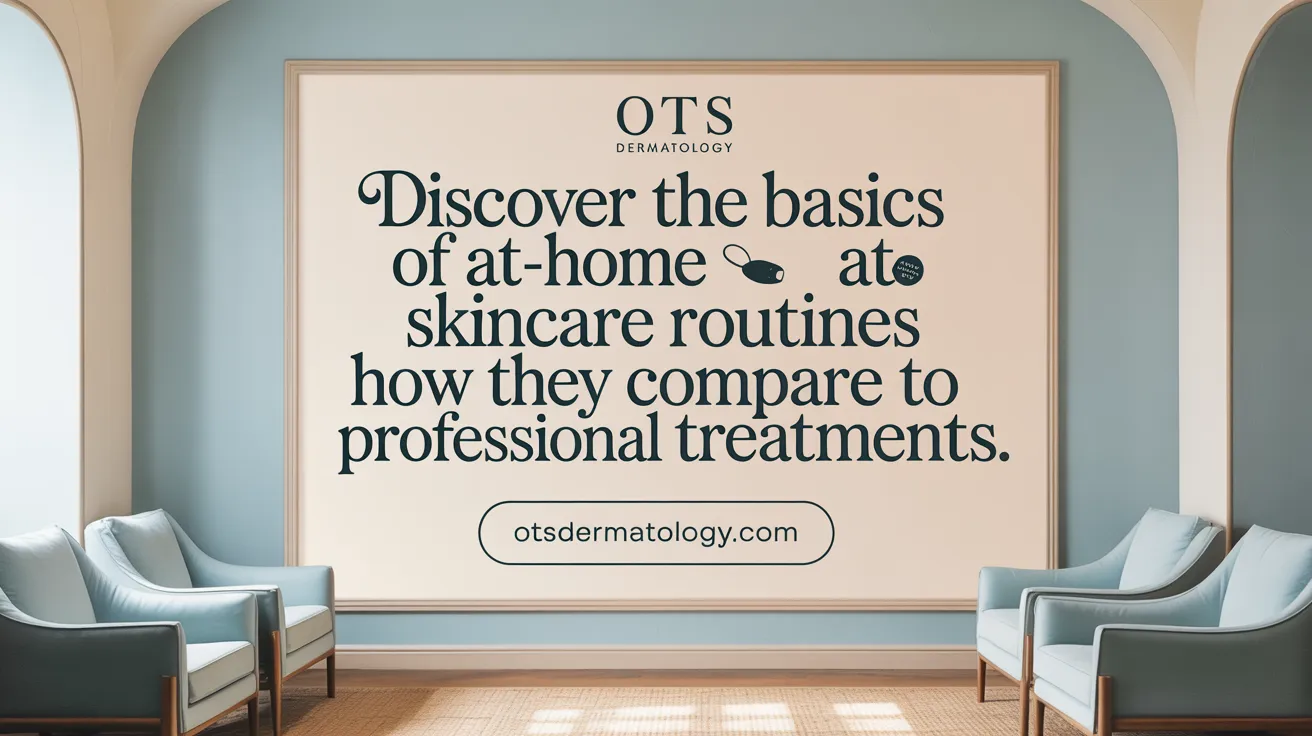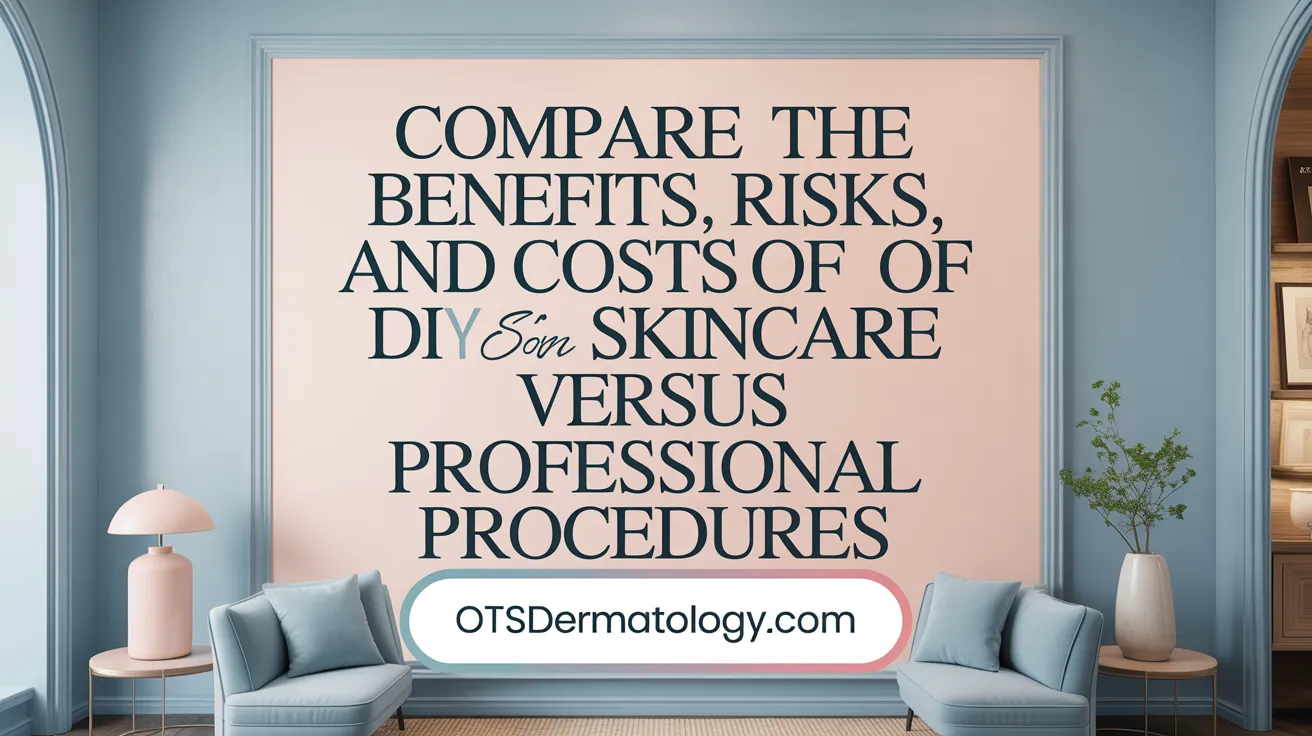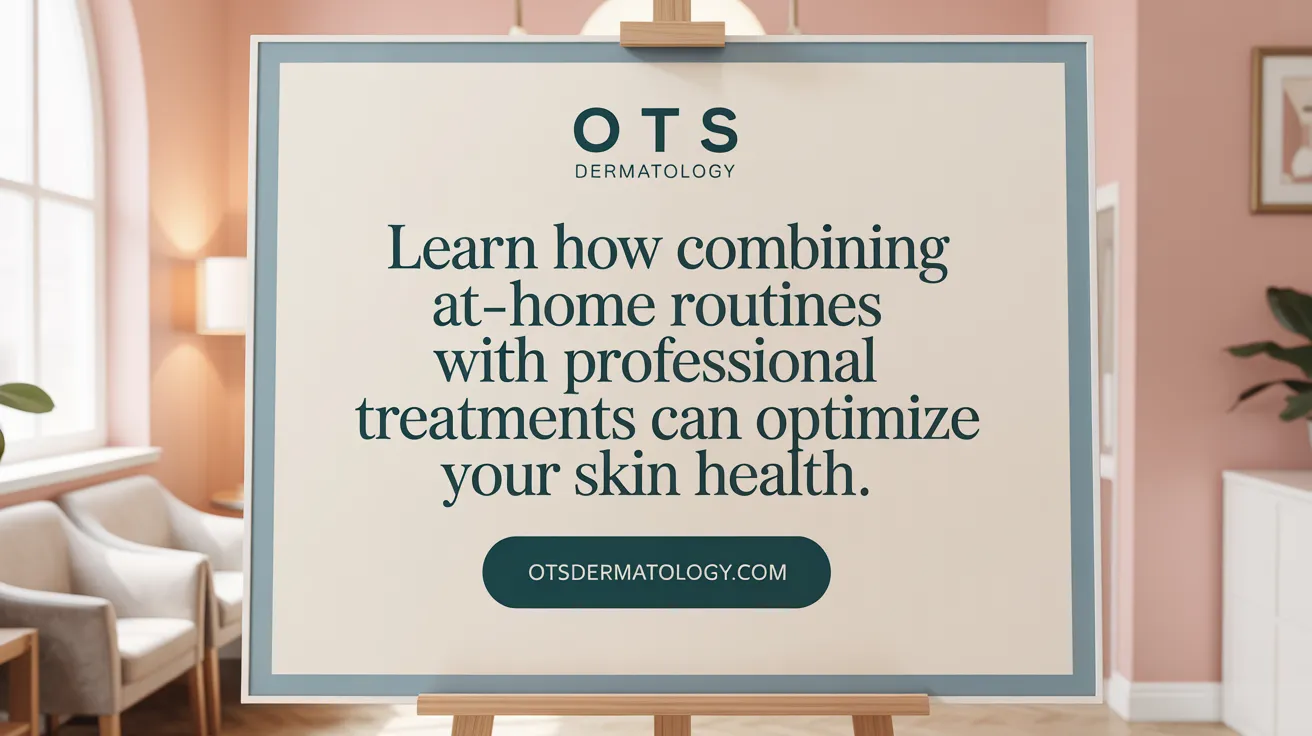Understanding Your Skincare Choices
In the pursuit of healthy, radiant skin, individuals face a choice between at-home skincare routines and professional treatments. Each option offers distinct benefits and challenges, impacting skin health, effectiveness, safety, and cost. This article unpacks the pros and cons of both approaches, helping readers make informed decisions tailored to their unique skincare needs and goals.
At-Home Skincare: Foundations, Benefits, and Limitations

What are the differences between at-home skincare routines and professional treatments?
At-home skincare routines typically involve daily use of products like cleansers, moisturizers, and exfoliants, providing basic maintenance that is affordable and convenient but limited in addressing deeper skin concerns.
Daily routines are essential for maintaining skin health, preventing buildup, and tackling common issues such as dryness or mild acne. These routines are accessible and easy to perform, making them ideal for regular upkeep.
Professional treatments, on the other hand, are administered by trained estheticians or dermatologists who utilize advanced techniques like microdermabrasion, chemical peels, and laser therapies. These procedures can target deeper layers of the skin and address complex issues such as deep scars, significant wrinkles, or pigmentation.
What are the benefits and disadvantages of at-home versus professional skincare treatments?
At-home treatments offer advantages like convenience, affordability, and safety when products are used correctly. They help sustain skin health between professional visits and can include simple remedies such as honey masks, sugar scrubs, or aloe vera gel.
However, their effectiveness is limited. While they can improve superficial skin conditions and provide hydration, they generally cannot treat more serious concerns such as deep wrinkles, significant scarring, or hyperpigmentation.
Professional skincare treatments, though more costly and sometimes requiring downtime, provide targeted, potent solutions with faster and more visible results. These include procedures like chemical peels, microneedling, and laser treatments, which can be customized for individual needs and achieve deeper tissue rejuvenation.
In summary, both approaches are valuable. Regular at-home routines maintain skin in daily life, whereas professional treatments offer enhanced results when tackling challenging skin issues or seeking more dramatic improvements.
| Aspect | At-Home Routine | Professional Treatment | Details |
|---|---|---|---|
| Cost | Lower | Higher | Cost varies; professionals use advanced equipment |
| Convenience | High | Moderate | Home use is simple; appointments needed for clinics |
| Effectiveness | Superficial | Deep and targeted | Professional treatments penetrate deeper |
| Safety | Depends on product use | Increased control and safety in clinics | Sterile environment, trained practitioners |
| Typical Uses | Maintenance, mild concerns | Severe issues, aging, scars | Tailored to individual skin needs |
Both at-home and professional treatments play vital roles in a comprehensive skincare routine. Choosing the right combination depends on individual skin goals, budget, and how severe the skin concerns are.
Professional Skincare Treatments: Customization, Technology, and Depth

What are the differences between at-home skincare routines and professional treatments?
Professional skincare treatments include procedures like chemical peels, microneedling, laser therapy, and dermaplaning, performed by trained estheticians or dermatologists. These treatments utilize advanced, medical-grade devices and carefully formulated chemicals that allow for deeper skin penetration. Unlike at-home routines, which mainly involve superficial cleansing and moisturizing, professional treatments target complex skin issues such as hyperpigmentation, deep wrinkles, scars, and signs of aging. They can deliver more immediate, visible, and long-lasting results because of the precision and depth enabled by professional technology.
What are the benefits and disadvantages of at-home versus professional skincare treatments?
Professional procedures offer customized solutions tailored to individual skin needs, often using high-grade tools and potent chemicals that cannot be safely used at home. These treatments can significantly improve skin tone, texture, and appearance, often with faster results. For example, chemical peels performed in clinics can deeply exfoliate, promoting collagen stimulation and addressing stubborn pigmentation.
However, professional treatments come with higher costs, potential discomfort, and some downtime depending on the procedure. Risks include skin irritation, redness, and, if not performed properly, adverse reactions. In contrast, at-home treatments are more affordable, convenient, and accessible. They use natural ingredients like honey, oatmeal, aloe vera, or gentle scrubs that soothe and exfoliate. Their results are usually subtler and require consistent use over time. Improper use or incompatible products at home pose a risk of irritation or ineffective outcomes.
Advanced techniques and modalities
Modern professional skincare employs a variety of advanced techniques such as microdermabrasion, chemical peels with varying strengths, laser therapy for pigmentation and wrinkles, and microneedling with deeper needle penetration. These modalities not only improve surface appearance but also stimulate collagen and elastin production in the deeper layers of skin, supporting long-term skin health.
Customized treatments by experts
Licensed estheticians and dermatologists customize treatments based on detailed skin assessments. They consider factors like skin type, concerns, seasonality, health status, and stress levels. For example, they may combine microneedling with a chemical peel or laser therapy to maximize results. This tailored approach ensures that each treatment aligns with personal skin goals and conditions.
Deeper skin penetration and more noticeable results
Professional devices allow treatments to reach deeper skin layers than at-home tools. Deeper penetration with medical-grade needles in microneedling can stimulate significant collagen growth, reducing scars, reducing wrinkles, and improving skin firmness. Similarly, professional chemical peels can remove multiple layers of damaged skin, revealing fresher tissue underneath.
Cost, safety considerations, and possible downtime
Professional treatments often cost between $200 and $600 per session, with multiple sessions needed for optimal outcomes. They can involve some discomfort, redness, swelling, and in some cases, temporary downtime. Safety is maintained through sterile environments and trained practitioners, reducing risks like infection.
Examples of advanced procedures
Some common professional treatments include:
| Procedure | Purpose | Additional Notes |
|---|---|---|
| Microneedling | Collagen stimulation, skin texture improvement | Performed with medical-grade needles, customizable depth |
| Chemical Peels | Exfoliation, pigmentation correction | Varying strengths, stronger in clinics |
| Laser Therapy | Wrinkle reduction, pigmentation | Uses focused light, requires trained operator |
| Dermal Fillers | Volume restoration, wrinkle smoothing | Gel-like substances injected beneath skin |
Finding the right balance between at-home skincare and professional treatments depends on individual goals, skin concerns, and budget. Regular professional treatments, combined with diligent at-home routines, can unlock healthier, more youthful skin.
Microneedling and Chemical Peels: Comparing Specific Treatments
What are the mechanisms and targeted concerns of microneedling and chemical peels?
Microneedling involves using fine needles to create tiny punctures in the skin's surface. This process stimulates the body's natural healing response, increasing collagen and elastin production. It is particularly effective for treating acne scars, wrinkles, large pores, stretch marks, sun damage, and uneven skin tone.
Chemical peels, on the other hand, use acidic solutions like alpha hydroxy acids (AHAs) or beta hydroxy acids (BHAs) to exfoliate the outer layers of the skin. They work by removing dead skin cells, revealing fresher skin underneath. Peels are well-suited for addressing surface issues like hyperpigmentation, sun spots, fine lines, and dull skin.
What are the advantages and disadvantages of microneedling?
Advantages:
- Promotes collagen production, leading to firmer, smoother skin.
- Can improve skin texture, scars, and signs of aging.
- Minimal downtime and discomfort.
- Suitable for various skin types.
Drawbacks:
- Results require multiple sessions for optimal effects.
- Risk of skin irritation or redness if not performed correctly.
- Less effective for deep scars or advanced signs of aging.
What are the benefits and limitations of chemical peels?
Benefits:
- Effective in resurfacing the skin and reducing surface pigmentation.
- Available in different strengths, tailored to individual needs.
- Can dramatically improve skin brightness and clarity.
Limitations:
- Stronger peels require downtime for healing.
- Risk of irritation or uneven results if improperly applied.
- Might not address deep wrinkles or sagging.
How do professional and at-home approaches compare?
Professional treatments, performed by trained dermatologists or licensed estheticians, utilize high-grade tools and stronger formulas. They allow precise control of treatment depth and can combine multiple procedures like microdermabrasion, chemical peels, or laser therapy for enhanced results.
At-home procedures tend to be milder, using lower concentrations of active ingredients or surface-level devices. They are more convenient and affordable but typically yield more subtle improvements and carry a higher risk of improper use or skin irritation.
How can both treatments be used together?
Using microneedling and chemical peels in tandem can offer comprehensive skin rejuvenation. For example, a mild peel can prep the skin for microneedling by removing dead cells, allowing deeper collagen stimulation. Conversely, microneedling may enhance the absorption of active ingredients from chemical peels applied later.
However, combining these treatments should be planned carefully under professional supervision to avoid skin irritation or damage.
| Aspect | Microneedling | Chemical Peels | At-Home Use | Professional Use |
|---|---|---|---|---|
| Mechanism | Collagen stimulation via needle punctures | Surface exfoliation with acids | Mild surface peeling | Deep skin resurfacing |
| Target concerns | Scars, wrinkles, pores, texture | Hyperpigmentation, dullness, fine lines | Surface issues | Deep scars, deep wrinkles, aging |
| Results | Gradual, multiple sessions | Immediate in terms of surface renewal | Subtle improvements | Faster, more dramatic results |
| Downtime | Minimal | Varies from none to several days | Little or none | Requires recovery time |
| Risks | Redness, irritation, infection (if not sterile) | Irritation, uneven skin tone | Irritation, inconsistent results | Higher risk, skin injury, irritation |
Both treatments have unique roles in skincare. Choice depends on individual concerns, skin type, and desired outcomes. Consulting with a skincare professional ensures the best approach for safe and effective results.
Evaluating Effectiveness, Safety, and Costs: DIY Versus Professional Procedures
 When choosing between do-it-yourself (DIY) skincare routines and professional treatments, understanding their comparative benefits and risks is essential.
When choosing between do-it-yourself (DIY) skincare routines and professional treatments, understanding their comparative benefits and risks is essential.
DIY skincare is highly affordable and convenient, making it accessible for regular maintenance. Popular DIY remedies include homemade masks with ingredients like honey and oatmeal, sugar scrubs, and aloe vera gel. These treatments can soothe and exfoliate the skin, improving appearance with minimal costs. However, their effectiveness is limited, especially for deeper skin issues like severe scars or deep wrinkles. Results are often subtle and variable, and improper use of ingredients may cause irritation or adverse reactions.
In contrast, professional skincare procedures are performed by licensed specialists using advanced technology and medical-grade products. They provide targeted, significant, and long-lasting results. Treatments such as chemical peels, laser therapy, microneedling, Botox, and dermal fillers are tailored to individual needs, addressing deeper skin concerns effectively. These procedures typically require a higher financial investment and may involve some downtime.
Safety plays a crucial role when evaluating these options. Professional treatments occur in sterile environments under expert supervision, reducing the risk of infections, irritation, or complications. Skilled professionals can customize treatments—adjusting needle depths for microneedling or choosing appropriate chemical peel strengths—ensuring safer and more effective outcomes.
Regarding costs, DIY routines are budget-friendly; supplies are inexpensive, and treatments can be done at home repeatedly. However, their lower impact may mean that they need frequent reapplication without delivering profound or lasting results. Professional procedures, though more costly upfront, often require fewer sessions over time to achieve desired outcomes, ultimately offering better long-term value especially for severe or persistent skin issues.
Both approaches carry risks. DIY treatments, if not properly sterilized or if inappropriate ingredients are used, can cause skin irritation or infections. Professional procedures have some associated risks—such as redness, swelling, or discomfort—but these are minimized with professional oversight. Additionally, professionals can manage complications effectively and adjust treatments for optimal safety.
In summary, DIY skincare routines are suitable for routine maintenance and minor concerns, offering affordability and accessibility. Professional treatments, however, provide deeper, faster, and more noticeable improvements, particularly for complex or severe skin issues. The decision ultimately depends on individual skin goals, budget, and the level of results desired.
| Aspect | DIY Skincare | Professional Treatments | Additional Details |
|---|---|---|---|
| Cost | Lower | Higher | Includes equipment, professional fees |
| Accessibility | Readily available | Requires appointment | Convenience varies |
| Effectiveness | Mild to moderate | Significant and lasting | Based on procedure complexity |
| Safety | Variable (depends on skill) | Higher, with sterile environment | Professional oversight reduces risks |
| Results Speed | Slow; consistent routine needed | Faster, more dramatic | Usually within weeks to months |
| Long-term Value | Less cost-effective for severe issues | Better for sustained outcomes | Investment in health and appearance |
Integrating At-Home and Professional Skincare for Optimal Skin Health

How can at-home and professional skincare treatments complement each other for better skin health?
At-home skincare routines are essential for daily maintenance, including cleansing, moisturizing, and sun protection. These practices help prevent buildup, dryness, and early signs of aging. However, they often lack the potency to deeply address issues like significant acne, scars, or aging concerns. Professional facials and treatments fill this gap by offering deep cleansing, exfoliation, and specialized procedures such as microdermabrasion or chemical peels. These treatments not only remove impurities more thoroughly but also stimulate collagen production and rejuvenate skin. Additionally, professionals provide personalized advice, teach proper techniques, and recommend high-quality, medical-grade products. When combined, these approaches work synergistically. Regular at-home care maintains skin health between visits, while professional treatments provide targeted, deeper intervention that enhances overall skin resilience and appearance.
What role do both at-home and professional treatments play in anti-aging skincare strategies?
At-home products primarily focus on daily hydration, mild exfoliation, and surface-level protection. Ingredients like hyaluronic acid, retinol, and antioxidants work gradually to improve skin texture and delay early aging signs. Conversely, professional treatments directly target deeper skin layers. Procedures like chemical peels, microneedling, and laser resurfacing accelerate collagen synthesis, improve skin elasticity, and reduce wrinkles more rapidly. This combined approach optimizes anti-aging efforts. Daily routines prepare the skin for treatments, and professional procedures amplify results, supporting improved skin firmness, elasticity, and overall youthful appearance over time.
How can individuals make informed decisions about choosing between at-home and professional skincare options?
Assessing personal skin conditions, goals, and lifestyle is vital. Mild concerns or routine maintenance are well-managed with consistent at-home skincare using quality products. For more persistent or severe issues such as deep scars, pronounced wrinkles, or sagging, professional treatments are recommended. These procedures are performed by licensed specialists using advanced technology, offering faster and more noticeable results. Consulting skincare professionals helps tailor a personalized plan, combining at-home routines with necessary in-clinic treatments. They can advise on frequency, suitable products, and procedures that align with individual needs and budgets. Overall, understanding the strengths and limitations of each approach enables people to make informed, balanced choices for maintaining and enhancing their skin health effectively.
Making the Right Skincare Choice for Your Needs
Choosing between at-home skincare and professional treatments involves understanding their distinct strengths and limitations. At-home routines provide essential daily care that supports skin health affordably and safely, ideal for maintenance and mild concerns. Professional treatments supply advanced, customized care yielding more dramatic and lasting effects for complex issues but at higher cost and potential risk. By combining both approaches thoughtfully—leveraging consistent at-home maintenance with periodic expert intervention—individuals can optimize skin health, address aging actively, and enjoy improved skin resilience and appearance tailored to their unique needs.
References
- At-Home Skincare vs. Professional Facials: Why You Still ...
- At-Home Microneedling Vs. Professional Treatments
- DIY vs. Professional Skincare: Find Your Best Approach
- At-Home Microneedling vs. Professional Treatments
- Top Benefits of Professional Facials vs. At-Home Skincare
- The Pros and Cons of At-Home vs. In-Clinic Chemical Peels
- Anti-Aging Skincare vs. Professional Treatments: What Works ...
- The Benefits of Combining Professional Facials with At- ...
